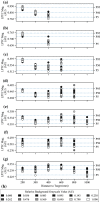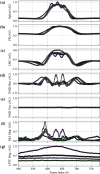Contrast independent biologically inspired translational optic flow estimation
- PMID: 36303043
- PMCID: PMC9691503
- DOI: 10.1007/s00422-022-00948-3
Contrast independent biologically inspired translational optic flow estimation
Abstract
The visual systems of insects are relatively simple compared to humans. However, they enable navigation through complex environments where insects perform exceptional levels of obstacle avoidance. Biology uses two separable modes of optic flow to achieve this: rapid gaze fixation (rotational motion known as saccades); and the inter-saccadic translational motion. While the fundamental process of insect optic flow has been known since the 1950's, so too has its dependence on contrast. The surrounding visual pathways used to overcome environmental dependencies are less well known. Previous work has shown promise for low-speed rotational motion estimation, but a gap remained in the estimation of translational motion, in particular the estimation of the time to impact. To consistently estimate the time to impact during inter-saccadic translatory motion, the fundamental limitation of contrast dependence must be overcome. By adapting an elaborated rotational velocity estimator from literature to work for translational motion, this paper proposes a novel algorithm for overcoming the contrast dependence of time to impact estimation using nonlinear spatio-temporal feedforward filtering. By applying bioinspired processes, approximately 15 points per decade of statistical discrimination were achieved when estimating the time to impact to a target across 360 background, distance, and velocity combinations: a 17-fold increase over the fundamental process. These results show the contrast dependence of time to impact estimation can be overcome in a biologically plausible manner. This, combined with previous results for low-speed rotational motion estimation, allows for contrast invariant computational models designed on the principles found in the biological visual system, paving the way for future visually guided systems.
Keywords: Bioinspired; Computer vision; Contrast dependence; Optical flow; Robotics; Time to impact.
© 2022. The Author(s).
Figures













Similar articles
-
Insect inspired vision-based velocity estimation through spatial pooling of optic flow during linear motion.Bioinspir Biomim. 2021 Sep 9;16(6):10.1088/1748-3190/ac1f7b. doi: 10.1088/1748-3190/ac1f7b. Bioinspir Biomim. 2021. PMID: 34412040 Free PMC article.
-
Exploration of motion inhibition for the suppression of false positives in biologically inspired small target detection algorithms from a moving platform.Biol Cybern. 2022 Dec;116(5-6):661-685. doi: 10.1007/s00422-022-00950-9. Epub 2022 Oct 28. Biol Cybern. 2022. PMID: 36305942 Free PMC article.
-
Optic flow-based collision-free strategies: From insects to robots.Arthropod Struct Dev. 2017 Sep;46(5):703-717. doi: 10.1016/j.asd.2017.06.003. Epub 2017 Jul 11. Arthropod Struct Dev. 2017. PMID: 28655645 Review.
-
A Bio-inspired Collision Avoidance Model Based on Spatial Information Derived from Motion Detectors Leads to Common Routes.PLoS Comput Biol. 2015 Nov 19;11(11):e1004339. doi: 10.1371/journal.pcbi.1004339. eCollection 2015 Nov. PLoS Comput Biol. 2015. PMID: 26583771 Free PMC article.
-
Optic flow based spatial vision in insects.J Comp Physiol A Neuroethol Sens Neural Behav Physiol. 2023 Jul;209(4):541-561. doi: 10.1007/s00359-022-01610-w. Epub 2023 Jan 7. J Comp Physiol A Neuroethol Sens Neural Behav Physiol. 2023. PMID: 36609568 Free PMC article. Review.
Cited by
-
Developing a Machine Learning 'Smart' Polymerase Chain Reaction Thermocycler Part 2: Putting the Theoretical Framework into Practice.Genes (Basel). 2024 Sep 12;15(9):1199. doi: 10.3390/genes15091199. Genes (Basel). 2024. PMID: 39336790 Free PMC article.
References
-
- Barth FG, Humphrey JA, Srinivasan MV. Frontiers in sensing: from biology to engineering. Amsterdam: Springer Science & Business Media; 2012.
Publication types
MeSH terms
LinkOut - more resources
Full Text Sources
Miscellaneous

